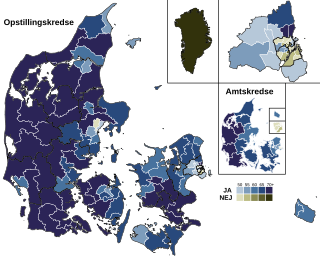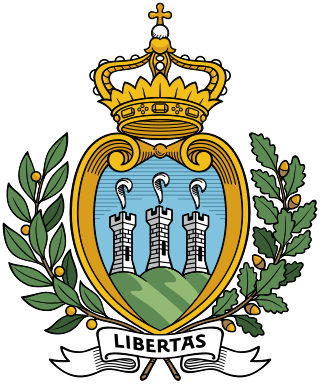A four-part referendum was held in Ukraine on 16 April 2000. The referendum was called by President Leonid Kuchma, and asked voters whether they approved of four amendments to the constitution that would increase the powers of the President and introduce an upper chamber.

A constitutional referendum was held in France on 24 September 2000. The proposal to reduce the mandate of the President from seven years to five years was approved by 73.2% of those who voted, but turnout was just 30.2%.
A referendum on retaining the monarchy or becoming a republic was held in Norway on 12 and 13 November 1905. Voters were asked whether they approved of the Storting's decision to authorise the government to make the offer of the throne of the newly self-ruling country. The Storting had wanted to offer the throne to Prince Carl of Denmark, but the prince insisted that the Norwegian people have a chance to decide whether they wanted to retain a monarchy.

Folketing elections were held in Denmark on 3 April 1939, except in the Faroe Islands where they were held on 19 April. They followed a dissolution of both chambers in order to call a referendum on changing the constitution. The referendum was held on 23 May but failed due to a low voter turnout. The result of the elections was a victory for the Social Democratic Party, which won 64 of the 149 seats. Voter turnout was 79.2% in Denmark proper and 47.8% in the Faroes.

A referendum on the enlargement of the European Communities (EC) was held in France on 23 April 1972. Voters were asked whether they approved of Denmark, Ireland, Norway and the United Kingdom joining the EC, although Norway later voted in its own referendum not to join. The proposals were approved by 68.3% of voters, with a turnout of 60.2%.

A non-binding referendum on the Single European Act was held in Denmark on 27 February 1986. It was approved by 56.2% of voters, with a voter participation of 75.4%.
A referendum on lowering the voting age from 20 to 18 was held in Denmark on 19 September 1978. It was held after the Danish government lowering the age of majority from 20 to 18 in 1976. The change was approved by 53.8% of voters with a turnout of 63.2%. The electoral age had previously been lowered from 21 to 20 in a 1971 referendum, after a 1969 referendum had rejected lowering the electoral age to 18.

A referendum on joining the European Economic Community was held in Denmark on 2 October 1972. The result was 63.3% in favour with a turnout of 90.1%. The law that Denmark should be member of the EEC was passed on 11 October 1972, and Denmark became a member on 1 January 1973.
A referendum on lowering the voting age from 21 to 20 was held in Denmark on 21 September 1971. The change was approved by 56.5% of voters, with a turnout of 86.2%. A previous referendum had been unsuccessful in lowering the electoral age to 18 years, which was introduced after a 1978 referendum and which still stands.
A referendum on lowering the voting age from 21 to 18 was held in Denmark on 24 June 1969. The proposed change was rejected by 78.6% of voters with a turnout of 63.6%. Two years later, the electoral age was instead lowered to 20 years, and finally, after a 1978 referendum, to 18 years.
A constitutional and electoral age referendum was held in Denmark on 28 May 1953. Both proposals were approved by voters, leading to both a new constitution taking effect on 5 June, and the electoral age being lowered from 25 to 23 years, also starting on 5 June. Voter turnout was 59.1% for the constitution question and 57.1% for the voting age question.
A constitutional referendum was held in Denmark on 23 May 1939. Voters were asked whether they approved of a new constitution. Although it was approved by 91.9% of those who voted, a turnout of only 48.9% meant that the percentage of eligible voters approving it was only 44.46%, below the 45% required by the existing constitution of 1915.
A constitutional referendum was held in Denmark on 6 September 1920. It was held in order to make changes to the constitution of Denmark from 1915 that had been made necessary to facilitate the reunification of Southern Jutland into the kingdom of Denmark. The changes were approved by 96.9% of voters, with a 49.6% turnout. A total of 614,227 of the 1,291,745 registered voters voted in favour, meaning that 47.6% of eligible voters had voted for the proposals, above the 45% required by the constitution.
A constitutional referendum was held in Iceland between 20 and 23 May 1944. The 1 December 1918 Danish–Icelandic Act of Union declared Iceland to be a sovereign state separate from Denmark, but maintained the two countries in a personal union, with the King of Denmark also being the King of Iceland. In the two-part referendum, voters were asked whether the Union with Denmark should be abolished, and whether to adopt a new republican constitution. Both measures were approved, each with more than 98% in favour. Voter turnout was 98.4% overall, and 100% in two constituencies, Seyðisfirði and Vestur-Skaftafjellssýsla.
A referendum on the Act of Union with the Kingdom of Denmark was held in Iceland on 19 October 1918. Voters were asked whether they approved of the Act, which would lead to Iceland becoming a separate kingdom under the Danish Crown, making the country a sovereign state in a personal union with Denmark. It was approved by 92.6% of voters.

A referendum on the electoral law was held in San Marino on 3 July 2005. Voters were asked four questions on changes to the electoral law and electoral system. Although all four were approved by a majority of those voting, voter turnout was just 21.7%, meaning that the quorum of 32% of registered voters (10,143) was not achieved for any question. This resulted in all four questions failing, including two that proposed raising the quorum to 40%.
Six referendums were held in Switzerland in 1979. The first four were held on 18 February on reducing the voting age to 18 (rejected), a popular initiative "for the promotion of footpaths and hiking trails" (approved), "against advertising for addictive drugs" (rejected) and "for ensuring people's rights and the security of nuclear power installations" (rejected).
Fifteen referendums were held in Switzerland during 2000. The first five were held on 12 March on reforming the judiciary and four popular initiatives; "for speeding up direct democracy ", "for a just representation of women in federal authorities", "for the protection of men against manipulations in procreation technology" and one to reduce motorised road by 50%. Whilst the judiciary reform was approved, all four popular initiatives were rejected. The next referendum was held on 21 May to authorise sectoral agreements between Switzerland and the European Union, and was approved by around two-thirds of voters.
Parliamentary elections were held in Iceland on 10 September 1908, alongside a referendum on prohibition.






